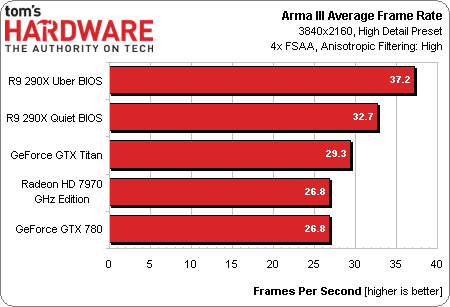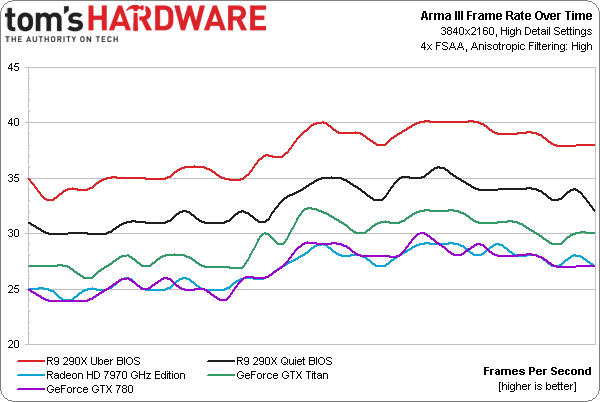Radeon R9 290X Review: AMD's Back In Ultra-High-End Gaming
After eight months of watching Nvidia go uncontested in the ultra-high-end graphics market, AMD has a new GPU based on existing technology that promises to challenge the top position. It gets mighty loud at times, but you can't ignore the R9 290X's price.
Results: Arma III At 3840x2160
Ultra HD presents us with some interesting challenges. To begin, while DisplayPort is the most logical interface between your graphics card and a tiled display, there is no way for us to use FCAT and DP for analyzing performance. The workaround is two HDMI inputs, one of which gets routed through a DVI splitter and into a capture card. But while Nvidia says this works fine, AMD is insistent that its controller doesn't support this configuration due to timing issues. That leaves us with Fraps. And of course, there’s no way for us to pick up dropped and runt frame using Fraps. So, we immediately shed the dual-GPU solutions from our charts.
What we’re left with, then, are five single-GPU boards at a dialed-down High detail preset in Arma III. The Ultra configuration we used on the previous page is simply too demanding. Even set to High, we see averages under 40 FPS at best.
Using the Quiet mode firmware, AMD’s Radeon R9 290X maintains more than 30 FPS, beating GeForce GTX Titan.
With that said, I can’t believe that anyone willing to spend $3500 on an Ultra HD screen today would compromise game settings to make a single-card gaming box playable. Calling R9 290X the best solution for a smooth experience at 3840x2160 is a red herring. In Gaming At 3840x2160: Is Your PC Ready For A 4K Display?, I concluded that you’d want at least two GeForce GTX 780s for 4K. And although the R9 290X is faster than even the $1000 Titan, I maintain that you need a pair in order to crank your settings up to where they should be.
Average frame time variance isn’t bad, but the AMD cards encounter less consistent delivery in worst-case measurements, which could manifest as more stutter when the going gets tough.
Get Tom's Hardware's best news and in-depth reviews, straight to your inbox.
Current page: Results: Arma III At 3840x2160
Prev Page Results: Arma III At 1920x1080 And 2560x1440 Next Page Results: Battlefield 3 At 1920x1080 And 2560x1440-
beta212 That's incredible. Especially at high res, I wonder how they do it. But the low price alone is enough to blow the competition away. Seriously think about it, it's around half the price for higher performance!Reply
- AMD: We're not aiming for the ultra high end.
I think Nvidia just got trolled. -
slomo4sho Great price point. This card has already broken world records just a few hours after release!Reply
-
esrever 2 of these for 4k looks amazing but Im a little disappointed by the power consumption when you crank up performance.Reply -
aznguy0028 I was thinking about hopping on the 7970ghz when it's on sale, but after seeing this, it's time to break apart the piggy bank for the 290x, what value!Reply -
Benthon Like the conclusion said, you just can't argue about aesthetics and thermals at this price point/performance. Well done AMD, lets see team green's response! Go consumer!Reply -
Shankovich Wow, and it's pegged at 73% too. Even if nVidia's "780ti" beats the 290X, it probably won't beat a 290X running at full power. And if mantle does make some big performance boosts, nVidia is going to be in a really tight spot. Looking forward to what they'll do. In the mean time, loving this competition! We all win in the end.Reply -
anxiousinfusion Wait the 290 X... X? is going to be $550?! Forgive me, padre for I have sinned.Reply



